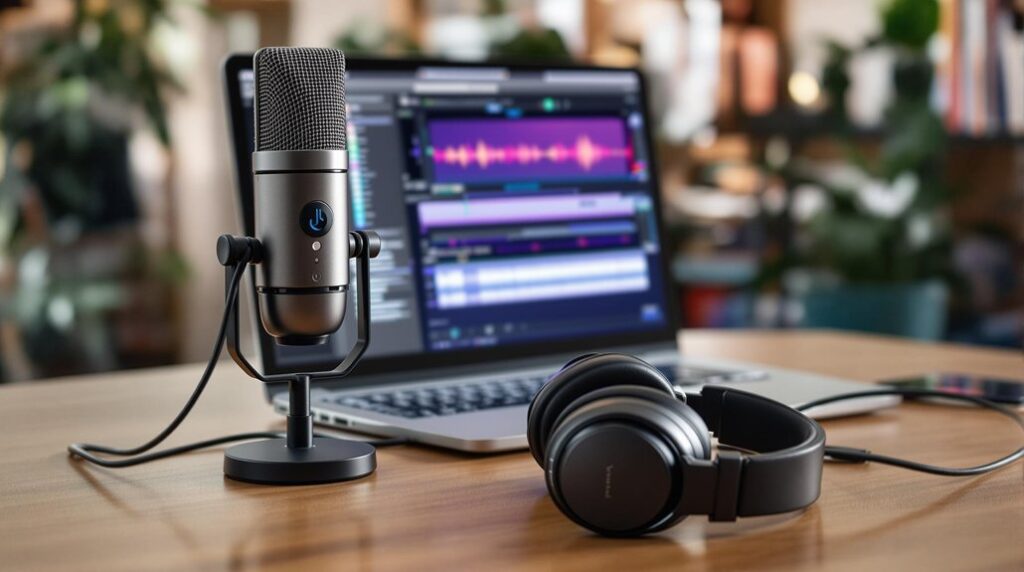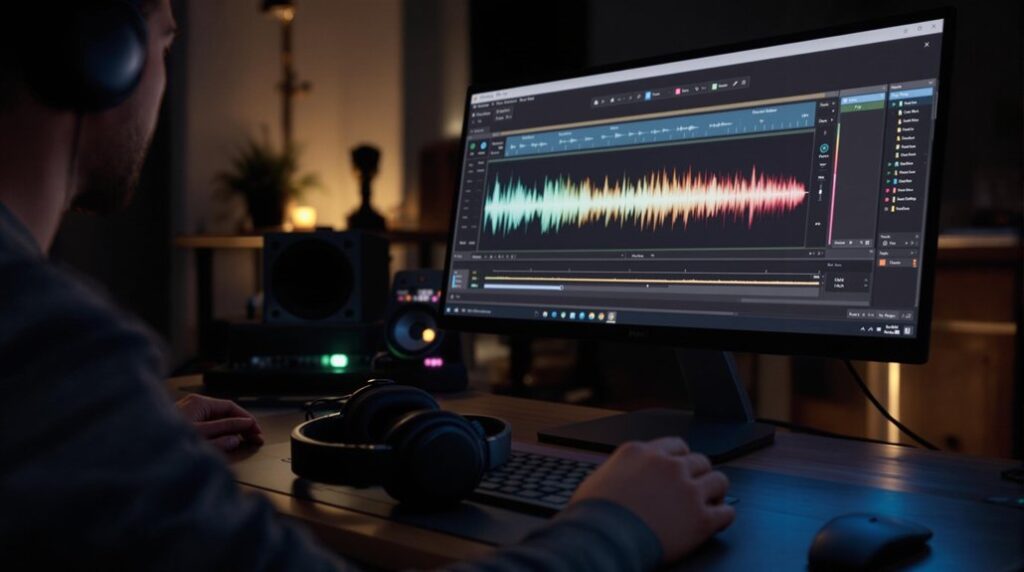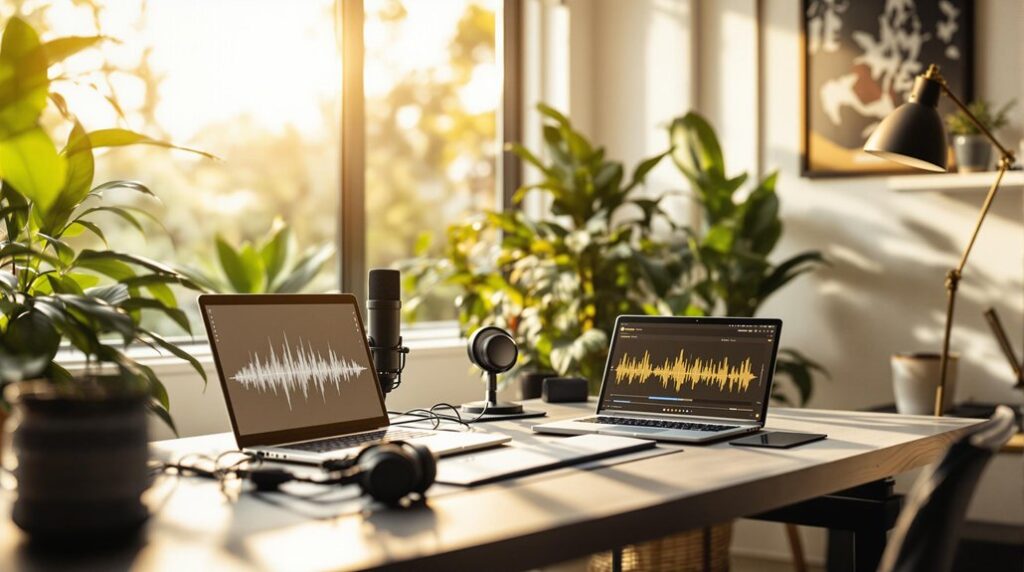To reverse audio in Audacity, first, download and install the software from the official website. Open your audio file using the File menu or drag and drop it into the workspace. Select the track by using Ctrl + A (Windows) or Cmd + A (Mac). Then, navigate to the Effect menu and choose the Reverse option. Preview your changes using the playback controls to guarantee satisfaction. To save your reversed audio, access the File menu, select Export, and choose your preferred format. Following these steps will enhance your audio projects considerably, and additional techniques await for those interested in expanding their skills.
Key Takeaways
- Download and install Audacity from the official website, ensuring compatibility with your operating system.
- Open your audio file using the File menu or by dragging and dropping it into the workspace.
- Select the entire track or a specific segment using Ctrl + A (Windows) or Cmd + A (Mac).
- Access the Effect menu and choose the Reverse option to apply it to your selected audio.
- Export the reversed audio via the File menu, selecting your preferred format like WAV or MP3 for sharing.
Why Reverse Audio?
Why reverse audio? Utilizing the reverse audio feature in Audacity can greatly enhance sound design by adding unique sound effects that invite creative experimentation.
This technique not only enriches audio projects across diverse media—including film and advertising—but also opens avenues for artistic expression. Reversing audio can obscure language, rendering speech unintelligible, which may be employed to eliminate inappropriate language or convey subliminal messages.
The versatility of this method allows for unexpected auditory experiences that captivate and engage listeners. By integrating intriguing sound effects into compositions, creators can deepen the impact of their work, ultimately leading to originality that distinguishes their audio projects in a competitive environment.
Getting Started With Audacity
Before exploring the intricacies of reversing audio, it is important to first familiarize yourself with Audacity, the software that enables such creative manipulation.
Getting started with Audacity involves several key steps that enhance your experience:
- Install Audacity: Download it from the official website, compatible with various operating systems.
- User-Friendly Interface: Familiarize yourself with the intuitive layout, which simplifies navigation.
- Audio Formats: Understand that Audacity supports multiple audio formats for both import and export, offering flexibility in handling different audio files.
- Opening Files: Use the File menu, the keyboard shortcut (Ctrl + O for Windows, Cmd + O for Mac), or drag and drop audio files into the program to begin working with its robust editing tools. Additionally, exploring comprehensive tutorials can greatly enhance your understanding of Audacity’s features and capabilities.
Download and Install Audacity
Audacity is a free, open-source audio editing software that can be easily accessed from its official website.
The installation process is simple; users need to double-click the downloaded file and follow the setup wizard’s instructions.
It is advisable to download the latest version to guarantee access to all features and improvements.
Free Software Access
While many audio editing tools require a subscription or one-time purchase, Audacity stands out as a completely free, open-source option. This accessibility allows users to reverse audio without financial barriers.
Key features of Audacity include:
- Compatibility with multiple operating systems, including Windows, macOS, and Linux.
- Straightforward import and export processes, supporting various audio formats, including WAV (Microsoft) as type.
- A user-friendly interface that allows easy navigation through the effect menu for audio manipulation.
- The non-destructive editing nature, enabling users to work with selected audio while preserving the original files.
Installation Process Overview
To commence your audio editing journey with Audacity, begin by downloading the software from its official website. This open-source audio editing software is available at no cost, guaranteeing you access the latest version of Audacity.
Confirm that the version you are downloading is compatible with your operating system—be it Windows 10, Windows 11, macOS, or Linux. Once the file is downloaded, initiate the installation process by double-clicking the downloaded file.
Follow the on-screen instructions provided by the setup wizard to complete the installation. After installation, you can launch Audacity and open audio files using the File menu or through keyboard shortcuts like Ctrl + O for Windows or Cmd + O for Mac, allowing for efficient audio editing.
Open Your Audio File
Launching the Audacity program is the first step to opening your audio file. To successfully open your selected audio file, follow these steps:
- Navigate to the File menu and select Open, or use the keyboard shortcut Ctrl + O (Windows) or Cmd + O (Mac).
- Browse your computer files to locate the desired audio file. Verify it is in a compatible format supported by Audacity.
- Alternatively, you can drag and drop the audio file directly into the Audacity workspace.
- Wait for the audio file to load fully, indicated by the waveform display in the timeline.
If any issues arise, confirm that the audio file is intact and that you are using the latest version of Audacity for peak performance.
Selecting Your Audio Track
Selecting your audio track is a crucial step in the editing process within Audacity. To initiate this, click directly on the desired audio track to guarantee it is highlighted for subsequent actions.
For efficiency, you can select the entire track by using the keyboard shortcut Ctrl + A (Windows) or Cmd + A (Mac). If you need to target a specific section, utilize the selection tool by clicking and dragging over the waveform.
For even greater precision, consider zooming in on the waveform, which allows for more accurate selections of specific audio parts. Always confirm that only the intended sections are selected before you apply an effect, as this will help achieve the desired outcome, such as reversing the audio.
Accessing the Effect Menu
Accessing the Effect menu in Audacity is a straightforward yet essential step for applying audio manipulations. To effectively utilize this feature, follow these steps:
- Navigate to the top menu bar where all primary options are displayed.
- Click on the “Effect” dropdown to reveal a list of available audio effects.
- Verify you have selected the audio track or desired segment that you wish to manipulate.
- Locate the “Reverse” option within the Effect menu to reverse the selected audio.
This menu not only allows you to reverse audio tracks but also enhances your creative possibilities in sound editing, such as using EQ settings to further refine the audio quality.
Applying the Reverse Effect
To effectively apply the Reverse effect in Audacity, begin by selecting the desired audio track or segment within the waveform. You can accomplish this by clicking and dragging over the waveform or using the shortcut Ctrl + A to select the entire track.
Next, navigate to the Effect menu at the top of the interface and choose the Reverse option from the drop-down list. This action initiates the reversal process, resulting in a visual change in the waveform, indicating the audio has been reversed.
Significantly, the Reverse effect is non-destructive, allowing for easy reversion to the original audio if necessary. After applying the effect, you can prepare for editing musical compositions or further processing.
Previewing Your Changes
Once the Reverse effect has been applied, it is crucial to assess the changes made to the audio track. Previewing your changes allows you to listen to the reversed audio and determine its quality effectively.
Follow these steps for ideal assessment:
- Use Playback Controls: Engage the Spacebar or Play icon to listen to the altered selection.
- Verify Selection Accuracy: Confirm that the selection within a time-stretched waveform is accurate, as only this segment will reflect the reverse effect.
- Observe Visual Changes: Notice the altered waveform for visual cues on modified segments.
- Adjust if Necessary: If the preview does not meet expectations, adjust your selection and reapply the reverse effect. Remember, you can always undo the reverse effect to experiment further.
Saving Your Reversed Audio
To save your reversed audio in Audacity, navigate to the File menu and select Export, followed by Export Audio.
In the Export Audio window, choose your preferred file format, such as WAV or MP3, and consider utilizing WAV with Signed 16 bit PCM encoding for ideal quality.
Additionally, you can edit metadata tags to enhance organization and guarantee compatibility with playback devices before finalizing the export.
Exporting Audio Formats
Saving your reversed audio in Audacity is a straightforward process that guarantees your work is preserved in the desired format.
To initiate exporting, navigate to the File menu and select Export, then choose Export Audio. You can choose from various formats, especially:
- WAV: Recommended for high-quality audio; use Signed 16 bit PCM encoding for ideal fidelity.
- MP3: A widely used format that balances quality and file size.
- Quality settings: Verify your selection matches the intended playback environment.
- Export progress: Monitor the export process to confirm successful completion.
Always check the format compatibility with your playback devices to avoid issues.
This careful approach guarantees your reversed audio retains its integrity across different platforms.
Metadata Editing Options
Effective metadata management is essential for ensuring that your reversed audio files are easily identifiable and well-organized within various media libraries and playback systems.
In Audacity, the metadata editing options are accessible in the Export Audio window, allowing you to input critical details such as title, artist, album, year, and genre. Accurately filling out this information is imperative for the effective organization and identification of audio files.
When exporting MP3 files, utilize ID3 tags, which provide a standardized method for embedding this information. Moreover, you can create custom fields in the metadata editor for any additional details pertinent to your audio projects.
Including extensive metadata enhances the professionalism and accessibility of your reversed audio when shared or published.
Tips for Advanced Users
Advanced users of Audacity can considerably enhance their projects by implementing a range of sophisticated techniques when working with reversed audio. The following tips will expand your creative possibilities and refine your audio manipulations:
- Utilize Sync-Locked Track Groups to maintain synchronization across multiple tracks during the reversal process, ensuring cohesive edits.
- Combine reversed audio with effects such as reverb and delay to create rich, layered soundscapes that improve the listening experience.
- Experiment with high-pass filters post-reversal to reveal unique tonal qualities and textures that might be obscured in the original track.
- Adjust the speed and pitch of the clip to transform its character, allowing for innovative sound design and unique sound effects.
These techniques foster deeper experimentation and mastery in reversing audio in Audacity.
Frequently Asked Questions
How to Reverse a Sound in Audacity?
To reverse a sound in Audacity, utilize audio editing features to enhance sound effects. Employ mixing techniques for track layering, ensuring ideal noise reduction and audio restoration while considering voice modulation for effective music production outcomes.
How to Put Audio in Reverse?
To put audio in reverse, utilize audio editing software to manipulate digital audio effectively. This technique is essential in sound design, enhancing sound effects for creative projects, music production, and voice recording, enriching the overall audio experience.
How to Select Inverse in Audacity?
To select audio in Audacity, utilize the user interface’s editing tools for track selection. Highlight desired segments, then access audio effects for manipulation. Adjust project settings to optimize playback options during sound editing processes.
How to Undistort Audio in Audacity?
To undistort audio in Audacity, employ audio effects such as noise reduction, equalization for frequency analysis, and the Repair effect for audio restoration. These techniques enhance sound quality and support effective sound editing and audio mastering processes.
Conclusion
In summary, reversing audio in Audacity is a straightforward process that enhances creative possibilities in audio production. By following the outlined steps—ranging from installation to saving the final product—users can efficiently manipulate sound files. The ability to preview changes before saving guarantees that the desired outcome is achieved. Advanced users may explore additional effects and techniques to further refine their audio projects. Mastery of this skill contributes to a more versatile approach to audio editing.




